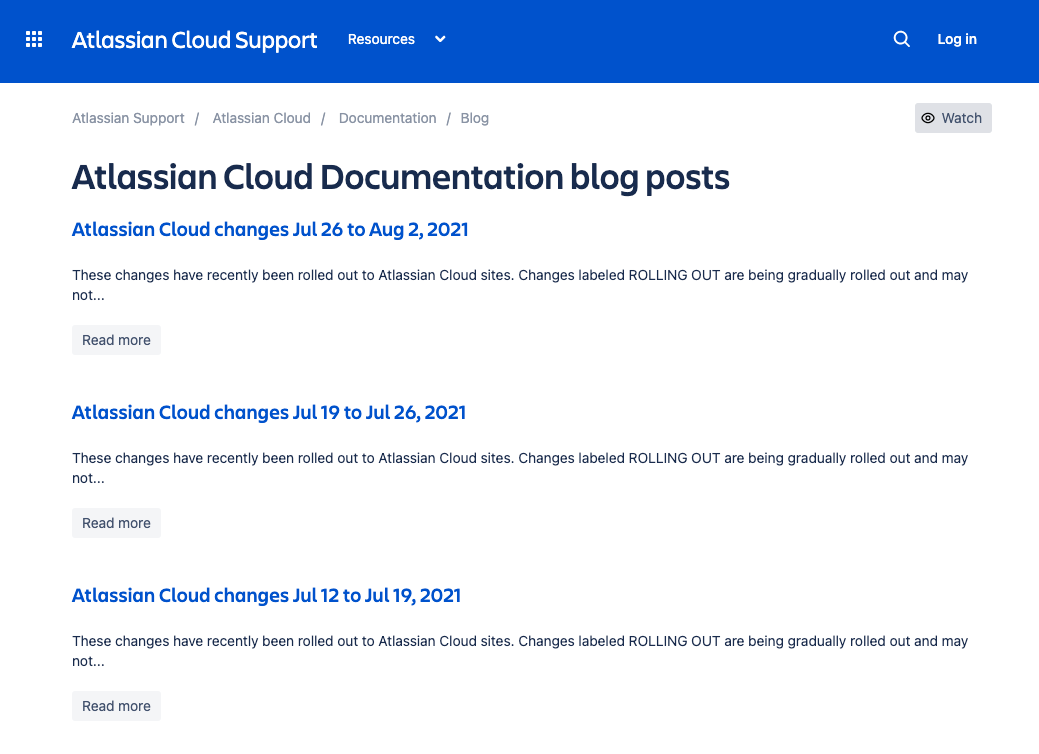As your organization’s admin, you act – in many ways – like the helmsman of its ship. Teams look to you to keep their tech stack sturdy – you outfit the organization with improvements and new technologies, and you navigate them smoothly through any and all product changes.
In a growing organization, even the smallest changes within your products can ripple into larger waves that affect your organization and your users. If updates roll out when you’re not prepared for them, your teams’ workflows can be affected, which can ultimately cause delays or disruptions.
Across the Atlassian platform, we are continually making changes to our cloud features and capabilities in order to improve your product experience and expand what you can do with Atlassian’s cloud products. Our own admins work with hundreds of teams stretched across multiple continents, so we understand that it helps to have a detailed plan allowing you to stay informed, prepared, and ready to implement these changes within your organization. That’s why we’re committed to making it as easy as possible for admins to manage change seamlessly in the Atlassian Cloud platform.
Atlassian’s philosophy for managing change at scale
At Atlassian, we’ve created a framework for rolling out product changes that follows your needs as an admin: making you aware of these changes, giving you the tools and time you need to prepare for them, and putting you in the driver’s seat when it comes to controlling how and when you implement these changes.
The first step to managing change is being aware of the changes that are coming. This means giving you advance notice for future changes that might affect your projects, workflows, and teams. We also want to provide as much detail as possible around the type of change we’re implementing (and why), the products and features that it’ll affect, and the time you can expect the change to take place.
The second step is getting prepared for the changes that are coming. This means giving you the ability to test changes ahead of time, understand how they impact your product instances, and fully digest how new features or changes will interact with your teams’ existing workflows.
Finally, we also understand that even when product changes are necessary, they may require a degree of control. For that reason, Atlassian provides options for you to control how frequently changes are released to your products, giving you the flexibility and space you need to prepare for and fully educate users on the changes ahead.
4 tips to help you manage change in the Atlassian Cloud
These four key tips for effective change management make it easy for admins to get notified, be prepared, and stay in control of upcoming changes to Atlassian’s Cloud products.
1. Follow Atlassian’s public roadmap
Atlassian is committed to communicating product changes openly with our customers and giving them notice about the changes well in advance. As such, our public Cloud Roadmap details all the planned changes that we have coming to the Atlassian Cloud platform and its products. Updated quarterly, our Cloud Roadmap details existing and future cloud feature and capability updates, so you can always see what’s coming next.
To navigate our Cloud Roadmap, use the filter menu on the side to view updates by product (such as Jira Software, Confluence, or Bitbucket), update status (such as new update additions or those recently shipped), or category (such as cross-product features, data management, or user management). Each update includes a short description that includes:
- the Atlassian Cloud products affected by the change
- the year and quarter the change is expected to launch
- a brief description of how the feature or configuration will work

To see which changes will be coming to the Atlassian Cloud platform as a whole, filter for Cloud platform as the product. Updates coming to the Cloud platform might affect one or more of the products you use.
Want to get a closer look at changes coming soon or further in the future? Toggle the status filter at the top of the page, and you can see which features will be launched within the current calendar quarter (“Coming soon”), within the next year (“In the works”), or later in the future (“Future”).
2. Subscribe to Atlassian’s weekly release notes
For those who would like to get more frequent updates on upcoming Atlassian Cloud changes, the Cloud release blog is a great resource. Each week, the Atlassian team updates the blog with changes coming to the Atlassian Cloud platform, Jira Software, Jira Service Management, Jira Work Management, Confluence, and Bitbucket.
Within each blog post, you’ll find recent and upcoming product changes arranged by product that includes:
- a concise explanation detailing the change
- a list of which products the change will affect
- where to navigate within each tool to see the change

To subscribe to these updates, simply click “Watch” in the top-right corner of the Cloud release blog.
3. Create a sandbox and put it on the preview track
Now that you’re in the loop when it comes to upcoming product changes, it’s time to learn how to preview and prepare for them. This is where Atlassian’s product sandboxes and release tracks – available to Cloud Premium and Cloud Enterprise customers – come in handy.
Atlassian’s product sandboxes are isolated environments where you can experiment with different features or upcoming changes before they roll out to production. Your sandbox acts like a production environment, and you can create one sandbox for each Premium or Enterprise production environment you have (including Jira Software, Jira Service Management, and Confluence). To create a sandbox, go to your organization’s Administration overview, navigate to Products > Sandbox, and select Create sandbox.
From there, you’ll select which product you’d like to create a sandbox for and then be notified when your sandbox is ready. Within your sandbox, you can make changes in the same way you would to your production environment. To ensure your sandbox matches your current production environment, copy your data from Jira Software, Jira Service Management, or Confluence into your sandbox.

Once you have a sandbox that looks just like your existing production environment, you’re ready to start previewing product changes within your sandbox. You can do this by putting your sandbox on the preview track in release tracks – which controls when and how new product updates are released to your sandbox – within your Administration overview. To get started, go to Products > Release tracks > Change track. From there, select the Preview track for your sandbox.
With the preview track enabled, a bundled group of new changes will be released to your sandbox two weeks before it’s released to your live production environment. This will give you time to explore the new changes, make tweaks as needed, and educate your users on how the change might impact their workflows. If you need to create educational videos or write tutorials for your users, you’ll have a month to do so before the same changes are released to your users.
4. Put your production site on the bundled track
As an admin, you can also control your organization’s rate of change by setting your production environment’s release track. Just as you can set your release track for your sandbox, you can set your product release track to control when updates will be released into your production environment.
When selecting the release track for your production environment, you can choose between a continuous release track (where product changes are released into your production environment as soon as they’re available) or a bundled track (where product changes are bundled together and released to your production environment on a monthly basis).
Adopting the bundled track for product releases helps you manage change in several ways. It allows you to control when users will experience new features, reducing the chances that changes will disrupt workflows or projects. When paired with the preview track in your product sandbox, you can better educate your teams around product changes ahead of time, letting them know exactly which changes are coming their way and when.
Interested in getting involved in early feature testing?
Atlassian is invested in continually improving its platform and products, and we’re committed to working with our customers to make these streamlined changes something to celebrate. If you’d like to get involved in early feature testing, reach out to us using Atlassian’s platform. If you need more support in managing change within your Atlassian products, explore our community board or get help from our support team.

